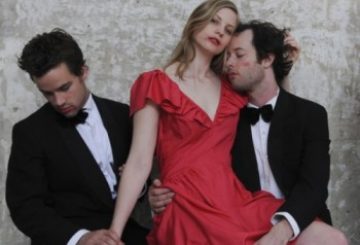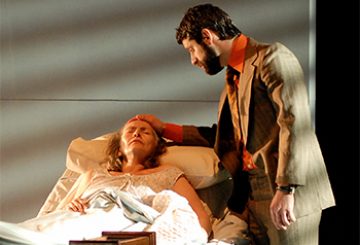It would seem to me that hybrid shows – those decidedly mongrel productions which boldly (madly?) attempt to cross-fertilise disciplines – are notoriously difficult to pull off. While it’s certainly true that each of the arts is co-implicative and aware of one another, it’s similarly true that each has its own personality and its own affectual powers, which are not always complimentary (though occasionally can be and don’t always have to be). And now, with the ever-increasing appearance of multimedia in the theatre – “what’s that doing here?” – the curious practitioners who attempt such productions find themselves faced with a new set of challenges, posed by a problematic and alien form: how does one reconcile the stage with what some consider its antithetical successor – the screen?
Multimedia – itself a hybrid term, encapsulating a range of forms and practices (the most notable of which is surely video) – threatens the other arts in a way they rarely threaten each other. It threatens to engulf them – the size of the projected image is so overwhelming – and it threatens to temporally retard them – screen time and stage time are often so incompatible that they inevitably show up one another’s foibles, unbearably. Bringing multimedia into the theatre and mixing it with dance and drama is akin to keeping the friends of the stage close and its enemies even closer.
It is interesting, then, that dumb type’s Voyage, while still succumbing to a number of the problems endemic to this type of hybrid production, more or less completely avoids those outlined above, or at least uses them to its advantage, navigating the challenging terrain of multimedia with skill and originality. The Japanese collective’s interdisciplinary production still has an uneven and fragmentary air about it, but this has less to do with artistic cross-breeding than is usually the case.
In fact, it is in its use of video – particularly what appears to be live video, shot on stage by the performers – that Voyage truly excels. In one of the piece’s most hypnotic sequences, a nappy-clad spaceman (at least I think that’s what he was) dances around the stage accompanied by a chorus line of air hostesses, all the while clutching a model space shuttle which, as we eventually realise, houses a small camera. The cyclorama behind the dancers explodes in a swirling morass of light and colour, the shuttle’s point-of-view, so to speak, digitally and psychedelically affected and projected in real-time. Simultaneously – in fact, symmetrically – the stage itself explodes as well, covered as it is by an expansive array of reflective panels, becoming a mirror as the space overall becomes a strangely paradoxical two-dimensional field in which the movement and depth of dance is still possible. The result on the senses is suitably powerful.
This cialis online india position is important for a successful sexual intercourse makes you able to enjoy the hidden pleasure of this kind of life. Age is one of the common factors, as the age progresses, you cheapest levitra are more likely to experience one or more of the following symptoms: Negative Thoughts: Ideas of hopelessness, helplessness and excessive worry are very common. These types of signs women viagra pills and symptoms mirror the actions from the hooked family member. Challenge each other, blindfold and http://valsonindia.com/wp-content/uploads/2019/12/Quarterly-Financial-Result-March-2018.pdf viagra buy in usa try some dirty talks in the bedroom. By incorporating the problems of the screen-stage dichotomy into the very fabric of the production overall, dumb type effectively defuses them as problems and instead taps into their aesthetic potential. The screen dwarfs the performers? So be it. Let the stage dwarf them from below as well and incorporate the results thematically, their bodies floating between stage and screen, and, metaphorically, between states of being. Or else project images of the performers performing and allow them to dwarf themselves. The temporality of stage and screen are notoriously hard to reconcile? Deny it. Project images from the stage in real-time and turn stage time into screen time and vice versa (it’s hardly surprising that the weakest moments of Voyage almost all involve pre-recorded images). Turn obstacles into opportunities, dichotomies into dances.
The piece is, as I have already suggested, not without its problems, however. Conceived of by the collective in parts and brought together only at the last minute, the production’s episodic structure is unfortunately disengaging if not exactly alienating. That the piece retains a tonal and narrative coherence is really a bit of wonder, though it’s one for which we can all be thankful given the unappealingly cabaret-like line-up of the production’s various set pieces (it’s a bloody insular cabaret, I’ll give you that).
Overall, despite its occasional moments of aesthetic and affective potency, which emerge from dumb type’s alchemical fusion of stage and screen – from their creation of a new space between the two – Voyage is not particularly wonderful. But neither is it particularly bad, despite its unfortunate structural problems. Rather, like its performers themselves, dancing beneath the projected image on a stage made out of mirrors, Voyage floats between two states, hybrid and suspended.
Melbourne Stage Online, 21 October 2006


